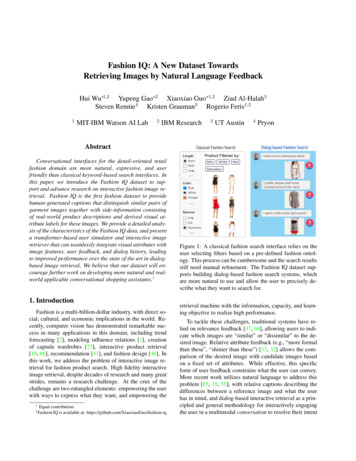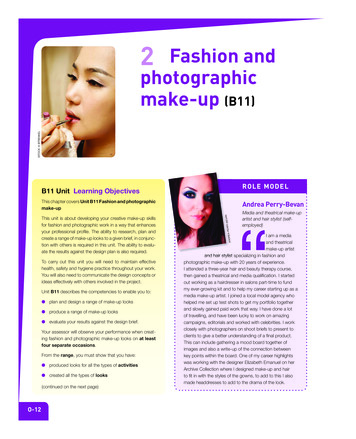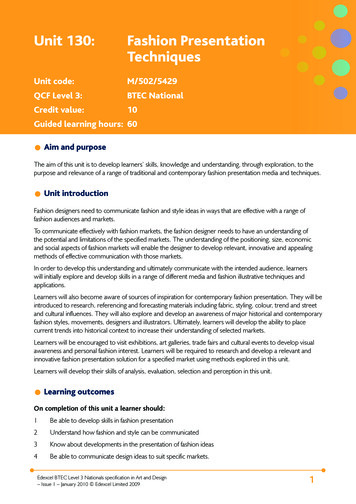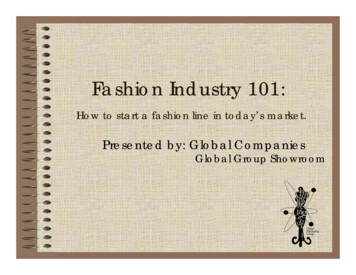
Transcription
MEN’S FASHION– A STUDY OF THE FASHION CONSUMINGBEHAVIOUR OF SWEDISH MENThesis for One-Year Master, 15 ECTSTextile ManagementFranziska FischerMaria Sunduk2017: 2017.18.03
Title: Men’s Fashion – A Study of the Fashion Consuming Behaviour of Swedish MenPublication year: 2017Authors: Franziska Fischer, Maria SundukSupervisor: Hanna WittrockAbstractEven though the fashion consumption of men has increased there are differences inconsumption in relation to women. Men’s consumer behaviour becomes more similar towomen’s consumer behaviour, which is an important moment in men’s fashion. The literaturereview is based on fashion and consumer behaviour. In this thesis consumer behaviour isconcerned with subcultures such as male consumers, Sweden and the Generation Y. Theconsumers of the Generation Y consume differently compared to former generations and it isthe most consumption orientated generation. A qualitative research was conducted tounderstand how men of the Generation Y consume fashion. In-depth interviews with eightSwedish men of the Generation Y were directed to understand what is important to them whenconsuming fashion. Further, the purpose was to find out what Swedish men want to expressthrough their clothing, what influences them concerning their consumption decisions and whymen think that they consume fashion differently than women. It was found out that theirpurchasing decisions are based on a combination of the fit, price and quality of the garment.Additionally, self-expression through clothing is important for the respondents. The pressure inthe Swedish society to fit in has also an influence on their decisions. Regarding consumptiondifferences between men and women the participants think that the price gap is the mostimportant factor.Keywords: fashion, style, male, consumer behaviour, Swedish men, Generation YI
AcknowledgementsFirstly, we would like to express our sincere gratitude to our supervisor Hanna Wittrock forthe continuous support and time during the process of writing our thesis and conducting ourresearch.Besides that, we would like to thank our primary grader Viveka Torell as well as our finalexaminer Jenny Balkow.Our sincere thanks also goes to our participants in the interviewees, who have willingly sharedtheir time and honest thoughts during the process of interviewing which made it possible for usto gain interesting insights in their consuming behavior.Finally, we would also like to thank each other, for the discussions, for hours and days we wereworking together before the deadlines, and for all the fun we had during the research process.Borås, the 4th of June 2017Franziska FischerMaria SundukII
Table of ContentsTable of Figures . .IV1Introduction . .11.1Background . .11.2 Former Research 21.3 Research Gap and Problem Description .21.4 Research Propose .31.5 Research Questions 31.6 Deliminations .42Literature Review .52.1Fashion 52.1.1 The History of Men’s Fashion . 62.2Consumer Behaviour . . .82.2.1 Culture and Subculture in Consumer Behaviour . .82.2.1.1 Nationality as a Subculture in Consumer Behaviour . 92.2.1.2 Age as a Subculture in Consumer Behaviour . .92.2.1.3 Gender as a Subculture in Consumer Behaviour . . 103Theory .133.1Consumption Criteria and their Influences. . 133.2Expression through Clothing 143.3Men’s Approaches to Fashion .143.4Men’s vs Women’s Consumer Behaviour 154Methodology . . . . 164.1Qualitative Research . .164.1.1Sampling in Qualitative Research 164.1.2Interviewing in Qualitative Research .184.1.2.1 Recording and Transcribing of the Interviews. .194.1.3Ethical Principles in Research .194.1.4Reliability and Validity in Qualitative Research .194.1.5Qualitative Data Analysis .205Findings . . . . 215.1Everyday Clothing Criteria .215.1.1Criteria of Daily Picking Clothes . 215.1.2Style . .225.1.3Age Matters .225.2Fashion Consumer Behaviour . .235.2.1Purchasing Criteria . . 235.2.2Price as an Important Factor for Purchasing Decisions . . .235.2.3Brands and Swedish Brands . . .245.2.4Consumption Based on the Need or Desire .245.2.5Online Shopping . 255.3Clothing as a Tool for Expression 255.3.1Inspiration for Clothing . . . .255.3.2Openness to Advice concerning Clothing . 265.3.3Self-Expression through Clothing . 265.3.4Reflection through Clothing . .275.4Men’s Fashion .275.4.1Current Fashion . . 275.4.2Men’s Fashion in Sweden . . .285.4.3Conflicts in Fashion . .295.4.4Masculinity is not an Issue in Fashion . . .295.5Comparison between Men’s and Women’s Consumer Behaviour .30III
6Discussion .326.1Discussion of Consumption Criteria and their Influences. . . . 326.2Discussion of the Expression through Clothing 336.3Discussion of Men’s Approaches to Fashion . .346.4Discussion of Men’s vs Women’s Consumer Behaviour .357Conclusion . 367.1Contribution . .377.2Limitations and Further Research 37References.VTable of FiguresFigure 1.6Figure 2.17IV
1. IntroductionThe first chapter introduces the background about the chosen topic and presents the formerresearch within this field. Further, the problem of the research and the research gap arediscussed. Finally, this chapter describes the purpose of this thesis, presents a specific researchquestion with three sub-questions and outlines the delimitations of this study.1.1 Background“Men buy, Women Shop”, according to the title of a study on gender behaviour conducted bythe Verde Group (2007). The study determines that gender differences in consumer behaviourare significant, and that they are even greater when understood in conjunction with age (VerdeGroup, 2007). There is a difference in consumption expenses between the genders, reflected inthe total revenues in 2014 for menswear which were subordinate with 127.3bn compared to 218.8bn in womenswear (Euromonitor International, 2015). However, the sales in menswearshows a tendency to grow, according to Euromonitor International (2015) the Europeanmenswear market in 2014 had a higher growth than the market for womenswear. The apparelmarket for women had a compound annual growth rate of 0.1% and the apparel market for mena compound annual growth rate of 0.5% between 2010 and 2014.This tendency of growth is even stronger in Sweden, as the annual report of EuromonitorInternational (2017) shows, the value of sales of menswear in Sweden grew by 3 % in 2016. Areason for the growth is the continued increasing interest among Swedish men in fashion andtheir own physical appearance. The relatively good state of the Swedish economy and theincreased disposable income also helped to increase the demand for menswear in 2016.Menswear in Sweden is expected to continue to increase at a higher rate than womenswearduring the next years (Euromonitor International, 2017). However, even if the consumption ofmenswear has increased, the total revenue of womenswear is still higher (EuromonitorInternational, 2015; Fashion United, 2015).According to Underhill (1999) there is a conventional wisdom that men do not like to shop andconsequently do not shop as much as women. Smith (2016) states, that men long time preferredquick and targeted shopping trips. However, the consuming behaviour of men regarding fashionhas changed. At least for the past, fashion is seen as “feminine” or “not masculine” and as aconsequence not connected to men (Edwards, 2016). Nevertheless, Otnes and Mcgrath (2001)state that shopping for fashion is no longer seen as a female prerogative and that this improvesthe self-esteem, self-expression as well as confidence of men. Men nowadays buy clothes onimpulse, scan websites for style ideas, try new brands and orient themselves on trends (Smith,2016). There is a shift in men’s shopping behaviour, they shop more like women do, which isaccording to Smith (2016) an important moment in men’s fashion.Fromm (2013) states that consumers of the Generation Y, the generation which is grown uparound the millennium consume differently compared to former generations. Bucuta (2015)defines the Generation Y as the group of people who is born between 1980 and 2000. The-1-
Generation Y, the Digital Natives is the first generation which is raised with the internet, theyare used to technology and new devices that empower the consumer. According to Wuest et al.(2008) it is the most consumption-oriented generation and Solomon and Rabolt (2009) statethat they are more interested in brands, fashion and style compared to older generations.1.2 Former researchThe continuous gap between men and women in their consuming behaviour has attracted theattention of researchers. When studying men’s consuming behaviour researchers have focused,for example on gay clothing styles (Dodd et al., 2005), men’s feelings about their bodiesinfluencing their clothing habits (Frith and Gleeson, 2004), masculine identity constructionthrough clothing (Rinallo, 2007), the influence of social and economic changes on maleconsuming behaviour (Galilee, 2002) or fashion consumption by divorced men (Moore et al.,2001). Van der Laan and Velthuis (2016) conducted a qualitative wardrobe study to investigatehow Dutch men dress themselves. The study shows how everyday clothing selection is codetermined by a wide range of material and functional aspects, rather than individualexpressiveness. The respondents express the feeling to rather dress in an authentic than a uniqueway, to avoid undesirable attention (Laan and Velthuis, 2016). Some of the studies about men’sclothing behaviour focus on men’s desire to support their masculinity through clothes. As anexample the study conducted by Frith and Gleeson (2004) explores whether English men’ssubjective feelings about their bodies influence their clothing practices. The results show thatmen have a lack of concern about their appearance and rather think of the practicality of theirclothing choices. However, the findings show how men are using clothes to conceal or revealthe body (Frith and Gleeson, 2004). Rinallo (2007) analyses the building of masculine identitythrough everyday consumption among male consumers living in Italy (Rinallo, 2007). Theresearch by Galilee (2002) focuses on how the economic and social changes are affecting youngEnglish middle-class men in their consumption, work, friendship and leisure. The studysupports the idea of a masculinization of consumption and also, the rather cautious thanspontaneous buying behaviour. Galilee’s findings further reveal that English men’s purchasingbehaviour is mostly based on quality, price, practicality and conformity (Galilee, 2002).1.3 Research gap and problem descriptionAs the presentation of the former research displays, research about men’s consuming behaviourin the past has rather focused on investigating individuality and masculinity expression of menthrough their clothing choices. These studies are investigating men’s desire to look moremasculine and what men in general want to show through their appearance. Further, the studiesare focused on men in particular countries or particular groups in the society, for exampledivorced men.Since the Generation Y consumes differently than former Generations and is being consideredas strongly influenced by technology and the internet (Fromm, 2013), it is highly relevant to-2-
gain a deeper insight in their consumption behaviour. Further, men’s fashion consumingbehaviour is not as much investigated as women’s consumer behaviour and therefore it issufficient to interrogate men’s consumer behaviour more deeply. Additionally, Sweden is seenas a small fashion centre and people are considered as fashionable and conscious about fashionand fashion brand (Skov, 2010), consequently it is adequate to choose Sweden to investigatethe fashion consumption of men of the Generation Y.There is a lack of information of what is important for men of the Generation Y in Swedenwhile consuming fashion, the influences on their consumption decisions and what they want toexpress through their clothing. Further, there is a shortcoming about men’s own thoughts onwhy men consume fashion differently than women. There is a research gap in providing adeeper understanding of what is important for Swedish men of the Generation Y regarding theirfashion consumption behaviour.1.4 Research purposeSince there is a lack in research about consumer behaviour of Swedish men of the GenerationY, the purpose of this research is to investigate what is important to Swedish men of theGeneration Y when consuming fashion. Further, it is interrogated what men want to expressthrough their clothing choices. Additionally, the influences on men’s consumption decisionsare studied, and finally, it is investigated why men think that they consume fashion differentlyin comparison to women.1.5 Research questionsThe purpose of this thesis leads to the following research question and as well as three subquestions which enables to examine the topic more deeply:Research Question:What is important for Swedish men of the Generation Y when consuming fashion?Sub-question 1:What do Swedish men want to express through their clothing?Sub-question 2:What influences men concerning their consumption decisions?Sub-question 3:Why do men think that they consume fashion differently compared to women?-3-
1.6 DelimitationsThe study is narrowed down by focusing on the consumer behaviour of Swedish men of theGeneration Y. The study investigates Swedish males while consuming fashion, what influencesthem and also, what they want to express through their clothing choices. Even though, the thirdsub-question in this research indicates to study consuming differences between men andwomen, the authors’ aim is to investigate the matter from the participants’ point of view. Thestudy is not focusing on women’s consuming behaviour, therefore it cannot be drawn a generalconclusion why men and women purchase differently. Since, this study investigates men’sconsuming behaviour in clothing, the study is focusing on apparel and fashion products.Furthermore, this study was limited by a timeframe of ten weeks, which indicates the necessityto narrow it down and focus on Swedish men and the Generation Y.-4-
2. Literature ReviewThe following literature review will cover and explain certain relevant terms for this research.It is divided into two main chapters which are fashion and consumer behaviour. Chapter 2.1explains the term and meanings of fashion as well as a brief history of men’s fashion. Chapter2.2 focuses on consumer behaviour including different subcultures in consumer behaviour suchas nationality, age which contains Generation Y and gender. The chapter about gender as asubculture includes gender differences in consumer behaviour and male consumer behaviour.2.1 FashionThe term fashion has several meanings. In a broader sense it refers to a change of processes thatoccurs when many people at the same time do the same thing (Skov, 2010). According toSimmel (1957) there are two strong social forces, which is on one hand the need to stand outand on the other hand the need to fit in. Fashion reflects the society and culture as well as howpeople define themselves (Solomon and Rabolt, 2009). In a more narrowed sense fashionrelates to women’s dress, and to a lower degree to men’s dress, especially to clothing andaccessories which change regularly. Nowadays, it is increasingly common to characterise alltypes of clothing as fashion since they undergo changes in style and form (Skov, 2010).Hollander (1995) describes fashion as what everybody chooses to wear in the morning to doevery day’s business. Most people’s clothing is based on the conscious desire not to lookfashionable, but to look right (Hollander, 1995). According to Skov (2010) this choice isinfluenced by practical constraints such as weather, social occasion and availability. Hollander(1993) states that “Cloth is apparently something basic to civilization” (p. 1) However, “beyondthis [.] is the visual appeal in the behaviour of any cloth while it is being used” (Hollander,p.1). Clothing is one of the most visible forms of consumption, and also one of the most visiblemarkers of social status and gender. In previous centuries, a person's occupation, regionalidentity, religion and social class could be identified through it (Crane, 2000). Finkelstein(1991) states that fashion is an attribute to create and display a self-image, it helps to dividegenders and also social classes. It can help to validate and establish a person’s self-identity(Solomon and Rabolt, 2009). Clothing is a form of communication, through which peoplecommunicate things about themselves, which typically categorizes them into some structuredstatus level and lifestyle pattern (Maynard, 2004; Davis, 1992). A greater diversity in trendsallows to have multiple identities, just with a different outfit and change of venue the personcan easily transform into a slightly different one (Finkelstein, 1991).According to Solomon and Rabolt (2009) fashion refers to a style that is accepted by a largegroup of people at a particular time. However, the terms fashion and style have a differentmeaning. In apparel, a style is a special combination of attributes which differentiates it fromothers in its category. New Styles are created and styles can be adapted, every now and then astyle can become fashion if it is accepted by enough consumers (Solomon and Rabolt, 2009).-5-
Even if, the durability of a particular style is varying, it can range from a month to a century,fashions are likely to flow in a predictable sequence. The fashion life cycle consists of theintroduction, acceptance, culmination and decline of the acceptance of a certain style. In theintroduction stage, the new apparel has been presented to a small group of fashion enthusiasts,who will help it to get known. During the acceptance stage, a large segment of the populationstarts to try the new style which increases its social visibility. In the regression stage, the stylereaches a state of social saturation. At some point customers get tired of it and start to lookforward to newer styles. The former style eventually ends up in the discount corner at a retailstore (Solomon, 2010).1.Innovation2. RiseIntroduction Stages3. Acceleration4.General5. DeclineAcceptanceAcceptance Stages6. ObsolescenceRegression StagesFigure 1: Fashion Life Cycle (Solomon, 2011)2.1.1 The history of men’s fashionThe male clothing of the elite was as extravagant as the females from the mid-fourteenth centuryuntil the late 18th and early 19th centuries, until The Great Masculine Renunciation, whichinfluenced men to abandon embellishment and exclusiveness for a sober, plain costume to leavevanity to women and be unconcerned with their appearance. According to McNeil andKaraminas (2009) as well as Shannon (2006) fashionable lacy cuffs and collars, powdered wigand rouged faces, delicate stockings and slippers became distasteful. Flügel (1934) states thatafter the first years of the nineteenth century, women’s clothes became as marks of contrast forthe male household in which they lived. He further argues, that men in the 19th century neededto be either dressed correctly or in good taste, all originality or beauty in clothing being left forwomen. Additionally, Flügel (1930) states that The Great Masculine Renunciation worked tominimize the desire of men to look extravagant, luxurious and attractive through their clothing,instead men found alternatives for showing off, as example through sports and their possession.-6-
However, men continued to express a desire for personal expression or self-display throughtheir clothing choices. This is supported by the fact that the 19th century’s fashion recordreveals several popular trends and ever-changing styles for men (Shannon, 2006). Therefore,the belief of The Great Masculine Renunciation that from this time cut and fit became moreimportant than beauty of men’s dress, hides a more complex reality (Wilson, 2003). It can alsobe supported by the new fashion phenomena among men which appeared in the late 18th andthe early 19th century called dandyism. Garelick (1998) explains it as a performance of a highlyfashionable, constructed social icon. Dandies cared to be seen and admired for their tastefulstyle by both, women and men. Further, dandies paid a lot of attention into details of theirclothes and accessories, their purpose was to create attention with their elegant and minimalisticway of clothing and to not attract undesirable attention (Garelick, 1998; Vainshtein, 2009).They followed the phenomenon: “To be well dressed, one should never be noticed” (Vainshtein,2009, p. 96).In the second half of the 19th century dandies received competition through a new stereotypecalled “Masher”. According to Kunzle (2004) both, mashers and dandies were male caricatures,who enjoyed attention through their flashy style of clothes and superior behaviour. Masherswere described as a large class of very young, soulless, snobbish and altogether very stupid andwould-be smart examples of manhood (Kunzle, 2004). The difference between dandies andmashers was that dandies were from the upper-class and mashers were from the middle- andworking-class. The dandy has gained the respect from the middle-class, however the elite sawmashers as the ones who tried to affect the upper-class through clothing and other manners butresulted in lowering their own image and reputation instead (Cook, 2008). Cook (2008) statesthat while dandies’ way of dressing was an expression of their nature, the mashers were focusedon gaining women’s attention through their appearance. Shannon (2016) states that the masherwas a dandy for the middle-class, who was consuming mass-produced, ready-made clothing.Due to the wish to live like the upper-class, mashers started to leave behind the middle-classvalues of working hard, being economically modest and following adult responsibilities(Shannon, 2016). Shannon (2016) further states that mashers tended to live an “easy-going lifestyle”, enjoying the spare time, sleeping during the day and partying at night. Mashers wereaffecting the separations between classes, which were before clearly divided by residence,education and occupation but also by the quality, fit and fashion ability of the clothing. Massproduction and department stores were offering cheap knockoffs for the middle-class to imitatethe elite. Yet, there still remained a belief that a person’s status, profession and nature werewritten on the body, which could not be imitated and difference between classes were stillnoticeable (Shannon, 2016).Among these historical stereotypes, there have also appeared several new terms of men’sfashion and consumption forms in the 21th century. As one of the examples “metrosexuality”by the cultural critic Mark Simpson. According to Coad (2008) metrosexual men can becompared to dandies, who share the same fundamental characteristics such as vanity andnarcissism and also tend to live an extravagant lifestyle. These men are not only conscious abouttheir body, but also brand loyal and imitating masculine identities through particular clothes,-7-
beauty products, and body services (Coad, 2008). Beside metrosexual men, two oppositecharacteristics called “retrosexual” and “übersexual” men appeared, which both indicate areturn to “real masculinity” (Barber, 2016). Barber (2016) describes the übersexual as an oldfashioned man with masculine values and retrosexual a man who refuses to take care of himselfas metrosexuals did. According to Aaker and McLoughlin (2010) retrosexual men areconsidered as real and traditional males, who tend to like football, reject feminism, be nostalgicfor the way things were, prefer below-casual clothing and do appreciate beauty products.2.2 Consumer BehaviourConsumer behaviour can be defined as the behaviour that consumers show regarding tosearching for, purchasing, using, disposing and evaluating products and services which theyexpect to satisfy their needs. It focuses on how individuals decide to spend their availableresources, which can be for example time, money and effort on consumption-related items(Schiffman et al., 2012). The term consumer behaviour describes different types of consumers.In this thesis the personal consumer who consumes goods for the final use by individuals isinvestigated. Private consumers are referred to as end-users or ultimate consumers (Schiffmanet al., 2012).2.2.1 Culture and Subculture in Consumer BehaviourSolomon (2010) states that, ”we simply can’t understand consumption unless we consider itscultural context” (p. 568). The anthropologist Clifford Geertz views culture as a set of controlmechanisms such as plans, recipes, rules, instructions for governing of behaviour. People aredependent upon the control mechanism of culture for ordering their behaviour (Schiffman et al.2012). In line with this Hofstede defines culture as “the collective mental programming of thepeople in an environment. Culture is not a characteristic of individuals, it encompasses anumber of people who were conditioned by the same education and life experience” (Hofstede,1980, p. 43).Members of a specific subculture maintain beliefs, values and customs that set them apart fromother members of the same society (Schiffman et al., 2012; Solomon, 2010). Additionally, theyadhere to most of the dominant cultural beliefs, values and behavioural patterns of the largersociety (Schiffman et al., 2012). Schiffman et al. (2012) defines subculture “as a distinctcultural group that exists as an identifiable segment within a larger, more complex society” (p.352). Subcultures could be for example nationality, geographic region, age, gender, occupation,social class, just to name a few. However, any group that shares common beliefs and customsmay be classified as a subculture. All consumers are simultaneously members of more than onesubcultural segment (Schiffman et al., 2012).This thesis analyzes customers who are members in a subculture defined through theirnationality, gender and age. Gender and age are two of the most basic ways in which to segmentconsumers in fashion markets (Jackson and Shaw, 2009). Lantos (2015) sees nationality as oneof the most common subcultural basis for subcultural segmentation.-8-
2.2.1.1 Nationality as a Subculture in Consumer BehaviourAccording to Schiffman et al. (2012) nationality is an important subcultural reference thatguides what people value and consume.According to Skov (2010) people in Sweden dress quite informally, but with orientation oninternational trends. There has also been a considerable development in designer fashion inNordic countries since the 1990s. Especially in Sweden with designer brands such as FilippaK, Ann-Sofie Back, Acne or Tiger of Sweden. These designer brands have a strong baseespecially in Sweden and some export, primary to Nordic countries. Further, the Nordic capitalshave considered themselves as small fashion centres, with fashion weeks and governmentalsupport (Skov, 2010).According to Euromonitor International (2017) the total amount of spending on apparel andfoot wear increased in Sweden in 2016. The increased sales come from growth of premiumproducts. Due to the trends emphasis on “well-dressed preppy styles” the sales in this sectionincreased. In Sweden small specialized brands and retailers emerged rapidly in 2016. Thisincludes brands specialized in particular products, e. g. the Swedish company Happy Sockswhich is specialized in fashionable socks (Happy Socks AB, 2017).According to Euromonitor International (2017) Swedes are fashion conscious and tend to trynew brands and consequently being interested in small niche brands which focus on a limitedarea.2.2.1.2 Age as a Subculture in Consumer BehaviourAge is a big part of consumer identity and therefore a suitable way to segment consumers(Jackson and Shaw, 2009; Solomon, 2010). When everything else is equal, consumers tend tohave more things in common with others of their age (Solomon, 2010).An age cohort consists of people of similar ages with similar experiences. Including the shareof common memories about cultural heroes, important historical events, etc. However, theterms and cut-off dates used to put consumers into generational cate
Even though the fashion consumption of men has increased there are differences in consumption in relation to women. Men’s consumer behaviour becomes more similar to women’s consumer behaviour, which is an important moment in men’s fashion. The literature review is










